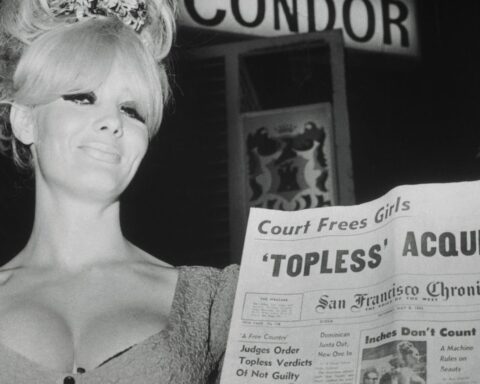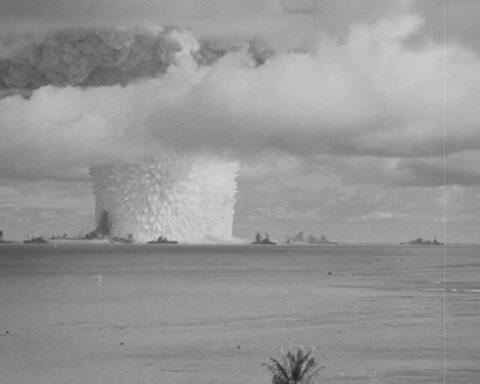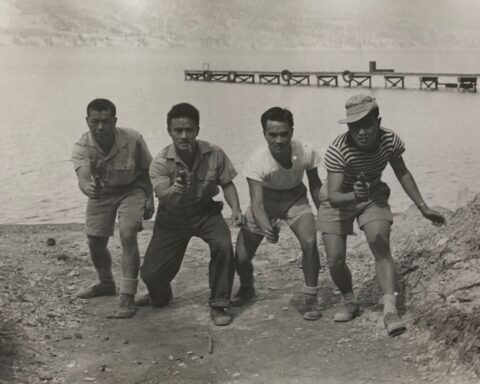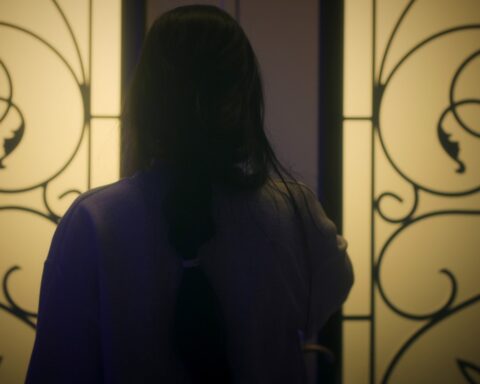A CONSTELLATION of poetic documentaries at this year’s Toronto International Film Festival cast off genre distinctions, not simply between documentary and fiction, but between cinema and memory. Loping along hand in hand with other recent work on place such as Tehran Has No More Pomegranates, Waltz with Bashir, Les Plages d’Agnès, La Mémoire des Anges and Of Time and the City each dwells on (and in) specific scenes and places to bring out an impression not simply of the past, but of a memory of a place—a personal engagement with that which is over. These documentaries are not about “real” events and situations; rather they document invisible experiences. As the filmmakers recoup their memories on film to paint fragmented self-portraits, place becomes a looking-glass entryway into the more subjective and surreal world of memory.
The focus on memory seems to have authorized these filmmakers to stray from all documentary pretenses to objectivity as they foray into the purely personal. This small adjustment in genre reminds us that the early-twentieth century gestation of documentary film occurred in tandem with an increasingly Freudian attention to not only the stories that screen each night in dreams, but also to memory, our personal daily cinema. Since those times, places have changed more and more quickly. Rural landscapes became urban scenes with breathtaking rapidity, neighbourhood demographics and atmosphere shifted equally quickly, and nostalgia for places, a sense of encroaching ruin, has become a feature of modernity.
Location, like the human face, gives photographers something to memorialize. These perceptions of places mingle in the location of the human brain itself, the place that casts itself up in contrast to the locations it remembers. By projecting distant places, by reflecting on them, and thus reflecting them, human memory itself becomes an intersection of other places. The movie theatre begins to overlap with the theatre of memory, and becomes an invitation to share visual experiences. The proof of this conjecture lies in how viewers leave with the visions of the cinema kept carefully in their back pockets and between their ears. We take films with us like places; films give themselves to viewers as new memories.
In the animated masterpiece Waltz with Bashir, Israeli director Ari Folman searches for the truth behind his lost memories of the massacres of Sabra and Shatila during the 1982 Lebanon war. The names of the places resonate in his mind in time to an unholy sense of his own indefinite complicity. Flares fire throughout the movie as though set off to light memories in a thorough darkness: a therapist friend of Folman tells him, “memory takes us where we need to go.” Memory in this film becomes a moving road backwards that individuals construct, create, and seek as much as follow towards the truth. The rotoscope- style animation of live interviews places the entire movie not as a document of a real experience, but as a conjured human fabric of reclaimed, or imagined vision.
One friend tells Folman he may sketch portraits of his family, “but don’t film.” The camera becomes a reprehensible eye, whose spurious claims to detail and accuracy endanger its subjects, and the truth of the past. Before the film ends with a shocking switch to newsreel video of the massacre as the man’s memories finally break over him, he realizes that his lost memories of these towns and their massacres were double symbols of his parents’ memories of Auschwitz: places and scenes of anguish mingle in memory. Folman’s achievement in this film is to have made visible a personal sense of overlapping memories, mourning, and guilt. Place is memory’s touchstone in this process.
Rather than seeking one specific memory of a place, Agnès Varda’s Les Plages D’Agnès uses the symbol of the beach as connective tissue between a hundred different scenes from her life. The film is an autobiopic, but one that uses place like others use the interview— as an entry into character. Varda frames life as an ongoing walk to and from, back and forth between beaches, from the water to the sea, from one thing to another, from change to change. The metaphor of the beach is potent. Wave to wave, tide to tide, sunrise to sunset, land to sea, beaches symbolize the changes in state that create stories.
As she uses the beach to elaborate visions of her past, Varda also focuses on interior spaces. She never films inside the home of her adulthood; rather, she stages a series of conversations and reconstructions in the coure interieure, the inner courtyard of her house. The space becomes a devotional room to be revisited like memory, even as it reminds viewers that recollected places are both inside and outside the mind, and that by making the film she has invited her audiences into herself, but not all the way. The coure interieure says, in effect, thus far, no farther.
Coupled with her avowal that she feels she has always lived in film, Varda’s quest through memory becomes more poignant when she confides that her mother lost her memory, and that there was freedom in that loss. Now, at 80, she too is beginning to forget. “I speak about memory in the film,” she says in an interview, “because it is a problem.” She describes weeks of searching through her full house for pictures and documents to film for the project. “Sometimes you don’t have an archive of what you want to remember,” she sighs with a grin. Sometimes, no doubt, the archive doesn’t corroborate what you remember, and other times, you must create the memories you’d like to have. Many of the images in the film tread a fine line between reconstructions of actual events, and enactments of visions Varda wanted to realize. Seeing a group of girls wearing the old swimsuits she and her sisters would have worn at Sète, even in fiction, “donne des frissons,” she says.
In homage to her famous teacher at the Sorbonne, Gaston Bachelard, Varda enacts a Jonah image, since he was obsessed with the story. A giant spandex whale constructed from scaffolding lies along a beach with its hump of stomach cut open. Varda herself sits placidly inside. This image twines memory and image making. While she notes the joy of realizing images that she’s carried with her for years, Varda is also stocking her memory and ours with images, as though to enrich the imagination. These images, however, always need spaces not only to be seen and created, but also to be dwelt in and revisited. Space is always responsible for experience and memory, even when, unexpectedly, one precedes the other.
Early in the film, as she explores her relationship to her childhood ocean-side home of Sète, she invites her brother along and tells him, “I asked you to come here to see what you might remember.” The memories he retrieves during this visit may be false: there is the implication that the space may prompt him to misremember in interesting ways. Varda’s motif through the piece of walking backwards—her small, round frame capped with a bright auburn coif doesn’t plod as much as tiptoes lightly backwards through the film—finally solidifies her persistently spatial metaphor for memory. We enact, act upon, activate the cultural meaning of places we live in and remember.
“Men who look at the sea,” says Varda in an apparent non sequitur partway through the film, “and children I like, I call Ulysses.” Ulysses is the guest of honour in this film, a figure who looks for what he’s lost, always suspended over the sea, whose map and sense of direction must be made of memory, even as it draws him into the future. In a turn reminiscent of Bashir’s conclusion, after the credits have run in Les Plages D’Agnès, the auteur’s voice returns, reflecting on a final party scene. “It happened yesterday and it’s already the past,” she says, “a sensation that will combine with images into a memory. I will keep remembering as long as I live.”
While Waltz with Bashir and Les Plages D’Agnès memorialize locations, and use place as a structure for memory, La Mémoire des Anges and Of Time and the City illustrate specific cities, Montreal and Liverpool, in voices and pictures that combine into impressions as intimate as injections of new memories. Luc Bourdon’s La Mémoire des Anges uses mid-twentieth century NFB footage of Montreal to create a city symphony that traipses along like a moving postcard, and exposes a rhythm of urban experience that drifts right off the screen. All the shots of crowds of feet walking detached from bodies, in heels and loafers, pound out this beat. “Avez vous remarquez les troittoirs?” asks a voice, expressing a childlike fascination with urban space, but also observing the sidewalks as a metaphor of the pathways, both personal and physical, that cities create and down which people go about their lives.
The narrow time period of the footage gives La Mémoire des Anges a strong sense of era: the fashion of the crowds, the forms of technology they use to travel, their pastimes, all ensure that this document is read as a picture of the past, an impression of a finished moment. The specific placement in time of the crowds in this film enhances their appearance of mortality, and contrasts with the striking timelessness of the architecture that surrounds them, from tenement walk-ups to modernist skyscrapers. The sense of place and rhythm Bourdon creates is so persuasive that the movie seems to be simply replaying the memories of people born in the 1920s or ’30s. This scrapbook of the dreams of earlier filmmakers seems to retrieve a Montreal that must have really transpired.
While the film is a celebration of the city’s spirit and character, it’s also a strange portrait of Bourdon, who reveals himself in the choices he makes about which moving snapshots to include, what duration to give gestures and what memories of the city to retain. Watching the film feels as intimate as falling into step with him on a walk through some alleyway. Since Bourdon’s selections transmit his impression of Montreal, and since the film recreates the city, the film confirms that memories create places as much as places impact memory. The walk through Montreal of La Mémoire des Anges comes to mirror a walk through memory itself; the shapes, tunnels, and turns of the city in time reflect the motion of remembering.
That most of the clips Bourdon uses are spliced out of context from other NFB movies gives the piece another dimension from which it speaks directly to the memory of the viewers: the film is partly a quiz on NFB cinema. The hoard of NFB footage then is “angels’ memories,” the sanctuary of movies that are never screened anymore, and the final viewing place for films that only exist in single copies in dark vaults and film archives. The film is an attempt to screen the memories stored in all the statues of angels that look out over Montreal and watch the people go by.
This idea of a sacred, or profane, perspective as the implied observer behind a city documentary also drives Terence Davies’ stunning Of Time and the City, which reconstructs the director’s impressions and memories of Liverpool, his hometown. Like Bourdon’s film, Of Time and the City relies to great effect on archival footage, but it differs in Davies’ addition of a collection of texts, poems, quotations, and snide or tender interjections narrated by his own dark and sensitive voice. With a tone and articulation as nuanced as John Gielgud’s, Davies sounds like an ironic Old Testament God, supposing God to be Peter Greenaway, that is. The feeling conveyed in his voice is at times excruciating as he brings out every elusive double meaning that each word could have. The effect is disarming in a genre that tends to downplay the value of spoken directorial commentary, as well as the communicative value of the word by comparison to the image. Of Time and the City exploits both to give the richest portrait of memory possible.
Unidentified as Davies in the film, and speaking words that are sometimes weirdly dissociated from the images, this powerful voiceover could almost be read as a found object, a recording added to the film because of its happenstance relevance. This murmuring voice comes across as a cynical worshiper who prays in satire to keep from screaming. The space of the church, therefore, on which Davies meditates as he relates his early faith and its loss, recurs as a location that is similar to memory, the mystic place where past experience is resurrected.
This mystic space is duplicated in the poetry Davies recites. The film opens with two nineteenth-century poems that find the past in landscape. Through Davies’ voice Houseman’s laments “the happy highways where I went, and cannot come again,” before Shelley’s bitter irony dismisses Ozymandias’ empire, nearly but not quite lost in the lone and level sands. As the film layers Davies’ memories of the practices and habits of the people he grew up with, the irretrievable happy highways of Liverpool begin to resemble the sidewalks of Bourdon’s Montreal. Davies’ voice, tenderly recounting his poems and snippets, makes poetry itself into a place to revisit, a dream of a former home.
His voice returns to an idea of Liverpool in pace with the reminiscing eye of his archival footage; the narration leads the viewer backwards with a beckoning finger. “Come closer now and see your dreams,” he says. “Come closer now and see mine.” These disarming words contain a profound description of cinema, which reminds us of ourselves, gives us new memories, and does us the profound honour of inviting us into another person’s theatre of dreams as a tourist. Space itself is the arena of remembering and sharing memory.
A geography made up of witnesses’ testimonies to the endurance of place grows out of Waltz with Bashir, Les Plages d’Agnes, La Mémoire des Anges and Of Time and the City. They extend the visual curiosity and purview of traditional documentary into the imagination. By focalizing remembered places they visualize the walls that make up the mind’s home. They defy categorization as documentary or poetry, true or false, and exhaust generic distinctions under the banner of extreme honesty. Each attends the birth of a genre that would make every painting, every story, and every film into a map. Paradoxically, even though all four are celebratory biographies of real places, ultimately they reissue the cultural currency of the ruin. Since the places of these films, Liverpool, Montreal, Sabra, Shatila, Sète, beg reconstruction in film, they are in some way already over, uncreated. This blankness these filmmakers perceive in the places that rankle with them is the taunt behind each of these films. Though remembering one thing clearly means losing most of what actually happened, each of these films plumbs this morass of forgetting to dredge up the reminiscences that linger in human corners despite the destruction of time.











